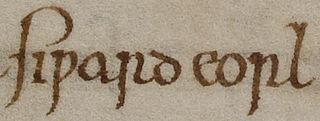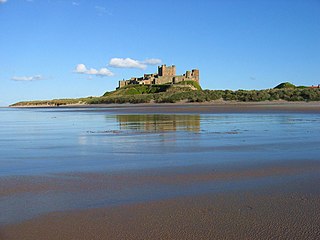Related Research Articles

Causantín mac Áeda was an early King of Scotland, known then by the Gaelic name Alba. The Kingdom of Alba, a name which first appears in Constantine's lifetime, was situated in modern-day Northern Scotland.

Amlaíb mac Sitric, commonly called Amlaíb Cuarán, was a 10th-century Norse-Gael who was King of Northumbria and Dublin. His byname, cuarán, is usually translated as "sandal". His name appears in a variety of anglicized forms, including Olaf Cuaran, Anlaf Sihtricson and Olaf Sihtricson, particularly in relation to his short-lived rule in York. He was the last of the Uí Ímair to play a major part in the politics of the British Isles.

Ælla was King of Northumbria, a kingdom in medieval England, during the middle of the 9th century. Sources on Northumbrian history in this period are limited, and so Ælla's ancestry is not known, and the dating of the beginning of his reign is questionable.

Siward or Sigurd was an important earl of 11th-century northern England. The Old Norse nickname Digri and its Latin translation Grossus are given to him by near-contemporary texts. It is possible Siward may have been of Scandinavian or Anglo-Scandinavian origin, perhaps a relative of Earl Ulf, although this is speculative. He emerged as a regional strongman in England during the reign of Cnut. Cnut was a Scandinavian ruler who conquered most of England in the 1010s, and Siward was one of many Scandinavians who came to England in the aftermath, rising to become sub-ruler of most of northern England. From 1033 at the latest, he was in control of southern Northumbria, present-day Yorkshire, governing as earl on Cnut's behalf.
Eadwulf or Eadulf was ruler of Bamburgh in the early tenth century. A genealogy in the twelfth-century text De Northumbria post Britannos recording the ancestry of Waltheof Earl of Northampton, makes Eadwulf the son of Æthelthryth daughter of Ælla, King of Northumbria, but no source names Eadwulf's own father.
The Battle of Corbridge took place on the banks of the River Tyne near the village of Corbridge in Northumberland in the year 918.
Uhtred of Bamburgh, was ruler of Bamburgh and from 1006 to 1016 the ealdorman of Northumbria. He was the son of Waltheof I, ruler of Bamburgh (Bebbanburg), whose family the Eadwulfings had ruled the surrounding region for over a century. Uhtred's death by assassination was described in De obsessione Dunelmi and has been interpreted as the beginning of a blood feud. Not to be confused with Uhtred the son of Eadwulf I of Bamburgh, which is why he historically has been referred to as Uhtred the Bold.

Oswulf was ruler of Bamburgh and subsequently, according to later tradition, commander of all Northumbria under the lordship of King Eadred of England. He is sometimes called "earl" or "high reeve", though the precise title of the rulers of Bamburgh is unclear. By the twelfth century Oswulf was held responsible for the death of Northumbria's last Norse king, Eric of York, subsequently administering the Kingdom of York on behalf of Eadred.
Waltheof was high-reeve or ealdorman of Bamburgh. He was the son of Ealdred, and the grandson of Oswulf I and was father of Uhtred the Bold, Ealdorman of Northumbria.
Owain ap Dyfnwal was an early tenth-century King of Strathclyde. He was probably a son of Dyfnwal, King of Strathclyde, who may have been related to previous rulers of the Kingdom of Strathclyde. Originally centred in the valley of the River Clyde, this realm appears to have undergone considerable southward expansion in the ninth or tenth century, after which it increasingly came to be known as the Kingdom of Cumbria.

The Battle of Carham was fought between the English ruler of Bamburgh and the king of Scotland in alliance with the Cumbrians. The encounter took place in the 1010s, most likely 1018, at Carham on Tweed in what is now Northumberland, England. Uhtred, son of Waltheof of Bamburgh, fought the combined forces of Malcolm II of Scotland and Owen the Bald, king of the Cumbrians. The result of the battle was a victory for the Scots and Cumbrians.
Eadwulf III of Bamburgh or Eadwulf Cudel or Cutel was ruler of Bamburgh for some period in the early eleventh century. Following the successful takeover of York by the Vikings in 866/7, southern Northumbria became part of the Danelaw, but in the north English rulers held on from a base at Bamburgh. They were variously described as kings, earls, princes or high-reeves, and their independence from the kings of England and Scotland is uncertain. Uhtred the Bold and Eadwulf Cudel were sons of Waltheof, ruler of Bamburgh, who died in 1006. He was succeeded by Uhtred, who was appointed by Æthelred the Unready as earl in York, with responsibility for the whole of Northumbria. Uhtred was murdered in 1016, and king Cnut then appointed Erik, son of Hakon, earl at York, while Eadwulf succeeded at Bamburgh.
Ragnall mac Bárid ua Ímair or Rægnald was a Viking leader who ruled Northumbria and the Isle of Man in the early 10th century. He was a grandson of Ímar and a member of the Uí Ímair. Ragnall was most probably among those Vikings expelled from Dublin in 902, whereafter he may have ruled territory in southern Scotland or the Isle of Man. In 917, he and his kinsman Sitric Cáech sailed separate fleets to Ireland where they won several battles against local kings. Sitric successfully recaptured Dublin and established himself as king, while Ragnall returned to England. He fought against Constantín mac Áeda, King of Scotland, in the Battle of Corbridge in 918, and although the battle was not decisive it did allow Ragnall to establish himself as king at York.
Events from the 10th century in the Kingdom of England.

Oslac ealdorman of York from around 963 to 975. His territory included but may not have been limited to the southern half of Northumbria. His background is obscure because of poor source documentation. The latter has facilitated disagreement amongst historians regarding his family and ethnicity.

The Rulers of Bamburgh were significant regional potentates in what is now northern England and south-eastern Scotland during the Viking Age. Sometimes referred to in modern sources as the Earldom of Bamburgh, their polity existed for roughly two centuries, beginning after the attacks on the Anglo-Saxon Kingdom of Northumbria by the Vikings in the later ninth century, and ending after the Norman Conquest later in the eleventh century. In Scottish and Irish sources of the period the Bamburgh 'earldom' is referred to as the kingship of the Northern English, or simply of the 'Saxons'.
Eadwulf II, nicknamed Evil-child, was ruler of Bamburgh in the latter half of the tenth century. Although Eadwulf is sometimes described as the Earl of Northumbria, he ruled only a northern portion of Northumbria, a polity centred on Bamburgh that once stretched from the Firth of Forth to the River Tees.
The English king Æthelstan invaded Scotland by land and sea with a large force in AD 934. No record of any battles fought during the invasion has survived and Æthelstan returned to England later in the year.
Adulf mcEtulfe may have been King of Bamburgh. The Annals of Clonmacnoise, note the death of Adulf mcEtulfe in 934.
References
- ↑ McGuigan, ′Ælla and the descendants of Ivar′, pp. 24–25, 33.
- ↑ Whitelock, p. 217; Davidson, pp. 200-209
- 1 2 Hudson, Ealdred
- ↑ Woolf, From Pictland to Alba, pp. 163–164
- ↑ ‘Ealdred (d. 933?)’, Benjamin T. Hudson, , Oxford Dictionary of National Biography, Oxford University Press, 2004. Retrieved 8 April 2015
- ↑ McGuigan, ′Ælla and the descendants of Ivar′, pp. 24–25.